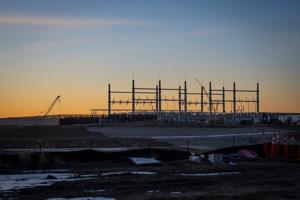Science
Data Centers Drive Economic Growth and Innovation in Communities

Reports regarding data centers often portray them as mere concrete structures filled with computers that consume excessive electricity and water. This narrow view fails to capture the broader significance of these facilities. For many forward-looking cities and towns, data centers are emerging as vital components of a diverse, resilient, and prosperous local economy.
Understanding the role of data centers requires recognizing their integral connection to everyday technology. When individuals search online for a recipe, access a cloud-stored file, or utilize services like ChatGPT, they rely on an extensive network of data centers distributed across the country. These facilities enable devices to retrieve information efficiently, underscoring their importance in today’s digital landscape.
Rural Communities Reap Benefits
One of the most significant impacts of the growing data center industry is felt in rural areas. Large facilities need ample space while remaining close to population centers to minimize latency, the delay in data transmission. As such, many projects are situated just outside metropolitan areas, providing access to major markets while taking advantage of more affordable land.
For rural counties historically reliant on agriculture or resource extraction, data centers offer a promising source of new tax revenue and investment in local infrastructure. While these facilities may not generate hundreds of onsite jobs like traditional manufacturing plants, their economic contributions extend far beyond direct employment. Data centers support a wide array of jobs in digital businesses, logistics networks, healthcare systems, and manufacturing reliant on constant data processing.
The fiscal advantages of data centers can be substantial. When paired with responsible local budgeting and planning, cities and towns can utilize investments from data centers to keep taxes low and bolster infrastructure. For example, data centers in Loudoun County, Virginia, provide $26 in taxes for every $1 spent on public services, significantly supporting local schools and development.
Addressing Misconceptions About Resource Use
A common source of confusion in discussions about data centers arises from misleading comparisons of their resource consumption to that of homes. Such comparisons often fail to account for the industrial nature of data centers, which inherently require more resources than residential properties. In context, the water and energy usage of these facilities should not incite alarm.
A high-end projection from the Department of Energy indicates that data centers could triple their electricity consumption by 2028. If this occurs, it would equate to approximately the same water usage as what is currently needed to irrigate 260 square miles of corn, accounting for around 1 percent of total corn irrigation in the United States. Additionally, leading data center companies are committing to enhancing water infrastructure and sustainability efforts.
To meet the anticipated demand for additional electricity, expanding local generation capacity will be essential. Tech companies have historically pioneered partnerships to bolster local energy resources rather than deplete them. For instance, in 2016, Microsoft invested in a natural gas plant for reliability and entered contracts with nearby wind farms to leverage regional energy resources, thereby strengthening the local grid.
Data centers serve a critical role beyond the tech sector, providing essential support for various industries, ranging from healthcare to finance, as well as entertainment services like video streaming. Communities considering their economic futures should view the establishment of data centers as opportunities for infrastructure development that will shape the next generation of growth.
Local leaders now face an important choice: to embrace the potential benefits that data centers can bring to their communities. The decisions made today will significantly influence the economic landscape for years to come.
Josh T. Smith is the Energy Policy Lead for the Abundance Institute, a nonprofit organization based in Utah. He coauthored a guide to data centers released in July 2023. You can follow him on X/Twitter: @smithtjosh.
-

 Lifestyle4 months ago
Lifestyle4 months agoLibraries Challenge Rising E-Book Costs Amid Growing Demand
-

 Sports3 months ago
Sports3 months agoTyreek Hill Responds to Tua Tagovailoa’s Comments on Team Dynamics
-

 Sports4 months ago
Sports4 months agoLiverpool Secures Agreement to Sign Young Striker Will Wright
-

 Lifestyle4 months ago
Lifestyle4 months agoSave Your Split Tomatoes: Expert Tips for Gardeners
-

 Lifestyle3 months ago
Lifestyle3 months agoPrincess Beatrice’s Daughter Athena Joins Siblings at London Parade
-

 World3 months ago
World3 months agoWinter Storms Lash New South Wales with Snow, Flood Risks
-

 Science4 months ago
Science4 months agoTrump Administration Moves to Repeal Key Climate Regulation
-

 Science3 months ago
Science3 months agoSan Francisco Hosts Unique Contest to Identify “Performative Males”
-

 Business4 months ago
Business4 months agoSoFi Technologies Shares Slip 2% Following Insider Stock Sale
-

 Science4 months ago
Science4 months agoNew Tool Reveals Link Between Horse Coat Condition and Parasites
-

 Sports4 months ago
Sports4 months agoElon Musk Sculpture Travels From Utah to Yosemite National Park
-

 Science4 months ago
Science4 months agoNew Study Confirms Humans Transported Stonehenge Bluestones









